The first half of 2020 has been dominated by the COVID-19 pandemic and its impact on our health and day-to-day existence.
As I write this, it’s difficult to make predictions even a few weeks ahead about what happens next. Still, it is likely that during the latter half of the year, Americans will be affected as much by the recession the pandemic has created, as by the disease itself.
If unemployment levels remain high or increase, people may start doing crazy things. During May, armed protesters in Michigan stormed the legislature, voicing opposition to lockdown rules. As the weather and the recession both heat up, numerous chaotic scenarios could emerge.
With governments providing social supports to people in need — taking on more debt to do so — and providing tax relief, our institutions could be weakened. Some will question the ability of governments to be there when we need them.
All these influences are feeding growing interest in different models for homes and businesses. It seems as if concerns about health, personal safety, security and cyber-security are leading to increasing interest in “off-grid” living (and off-grid campuses for organizations).
Passive House + Earth Tube
“Off-grid is how our house has been described, but we’re not completely there,” says Andrew Michler, an architectural technologist living with his wife in the foothills of the Rocky Mountains north of Denver.
The self-built house operates independently from the electric grid because it’s a passive house envelope with an earth tube, a traditional 8-watt water heater, some coils, a 35-watt heat recovery ventilator (HRV), rainwater collection and filtering, and a cooktop — all fueled by photovoltaic (PV) solar panels, a 12-kilowatt battery bank and a bit of propane.
The total load is equivalent to about 60 kilowatts, which Michler says is comparatively low. “Some people couldn’t get down to 60 even if they turned off everything in their house,” he notes. “I tell people about my house and explain that they’ve been doing Passive House for decades in Europe; they don’t believe me. Eighty percent or 90 percent less heating? They think I’m making it up.”
Michler adds that he’d like to “get off the carbon grid and drive a Tesla. But as of now, we’re still on the grid in terms of transportation, the Internet, food and the financial system. The idea of total independence might be a fantasy, but I think we are all going to have to be more resilient in the way we live.”
He recently purchased more solar panels, which have dropped significantly in cost since he started buying them in 2014. He also began work on a house design for a new neighbor who also wants a mostly off-grid existence.
The pandemic is shining a light on the issue of escaping the rat race and on indoor air quality, Michler says. “Many people have been staying home more in poorly built city structures with HVAC systems that often keep recirculating the same air,” he explains.
His home’s HRV brings in more fresh air while retaining the heating or cooling energy before expelling stale air. In addition, all the building materials in the Michler home were selected with IAQ in mind — from the cellulose insulation to the preference for raw indoor timber.
The earth tube is a re-emerging concept that works well with modern low-load systems. In this case, Michler repurposed 250 feet of 4-inch water main lines that had been abandoned on the site. They are buried 6 feet belowground and supply outdoor air to the HRV. They harvest 5 to 10 degrees of ground-source temperature differential for pre-warming in the winter and pre-cooling in the summer.
It’s the same principle as geothermal, but very low tech, using air rather than liquid. It’s vital to ensure the earth tubes are sloped to drain moisture and avoid mold. In large commercial applications, fans and pathogen monitoring are added.
When the Michler’s first purchased the land, there was a small existing shack. “It began falling apart as soon as we moved in, so we built this house from scratch, and what’s left of that original building is now part of the expanded work shed,” Andrew Michler explains.
He talks about the relatively high cost of battery storage and says reducing energy consumption is critical for a successful off-grid home. It’s why he gravitated toward low-load models that require very little active space conditioning.
“At the beginning, it was all about energy, but now I’m thinking about it more in terms of health and comfort,” Michler notes. “We may not be completely off-grid, but we’re breathing good air inside and outside. We’re fairly resilient and very comfortable.”
Futuristic 3D-Printed Home Pods
Although the inside of the Michler’s home feels contemporary, from the outside, it may look like the traditional 1990s’ off-grid mountaineer project. The fact that it’s self-built over 20 years fits that mold. But a different kind of off-grid model is emerging in the 2020s: the factory-built, high-tech, self-sufficient futuristic home pod, such as those found at haus.me.
One of the news reports on the website suggests the product is what you would get if Apple and Tesla got together to design a house. These are 3D-printed, 400-square-foot (or larger), well-sealed, pod-like homes, self-contained or grid connectible with loads of green and high-tech features. There’s at least one similar competitor called coodo that we know about, and there are probably others. We talked to haus.me, which has prefab plants in Seattle and Germany.
“I’m from Europe and we think about energy a lot because it is expensive there, and because we worry about climate change,” says Max Gerbut, CEO of haus.me. “Now, Americans are starting to think this way and we have 39 orders, more than enough for our Washington state plant to build during 2020.”
The prefabricated, polymer homes are highly insulated, but they have plenty of glazing on two sides for enjoying sunlight and natural surroundings, depending on where they are located. You can buy a double or a quadruple, and so on.
The company jokingly claims it has “standard zombie protection.” The remote-control, tinted windows are 6-pane tempered glass, with integrated smart blinds and an insulating value of R-24. There’s no mention of whether they are bulletproof, but they seem to be more protective than the photographs might suggest. Walls are 9-inch-thick polymer composite at R-54. The polymer never needs painting and there’s a lifetime warranty on walls, insulation and corrosion.
Gerbut explains that the HVAC is easy because the house is super-insulated. It comes with a heat pump and an HRV, a remote phone-controlled Nest smart learning thermostat, electrocatalytic filters, anti-allergy filters and air ionization — for 99.9 percent protection from bacteria and viruses, high-level dust and odor control.
Potable water offerings are conventional hookups, high-tech air humidity collection, or both. “Sewage can be managed through a conventional connection or the included 345-gallon tank that requires pump-outs,” Gerbut explains. “Another 345-gallon tank can optionally collect greywater from sinks.”
A third 52-gallon reserve tank is part of the potable water purification system, which Gerbut describes as membrane-based and highly advanced, capable of purifying about 7 to 9 gallons each day of rainwater, well water, river or lake water. “Any water except saltwater,” he says.
The kitchen includes a built-in espresso machine, steam oven, microwave, refrigerator, hands-free electronic faucet and dishwasher. The bathroom also is equipped with a hands-free faucet and a smart mirror. An optional shower water filtering and recirculating system can save 90 percent of the water and 80 percent of the energy, according to the haus.me website.
The solar power system is integrated right into the roof of the pod — a 7.4-kilowatt-hour thin-film array (for cloudy places), coupled with a 10 kWh or 24 kWh lithium-ion battery, and optional grid hookup. Each home is beautifully equipped with built-in LED dimmable lighting and motion sensors. The security system also uses motion sensors for indoors, and cameras with facial recognition for outdoors. Fingerprint security and remote access door locks are standard.
The haus.me homes offer an estimated lifetime of 60 years, with a five-year warranty, optional 10-year warranty extension, and maintenance plans if you want them. They’re not inexpensive. For a single pod, the base finance price is $1,163 per month for 20 years. The company suggests it’s like living for $750 per month due to savings on utilities, maintenance and so forth.
If you bought a pod outright, they start at about $200,000 for the single pod, $379,000 for the double pod. Flatbed-truck shipping from the Seattle factory is $4 per mile.
N.C. Off-Grid Dream Home
These two examples are small homes for living lightly, independently and relatively economically. The Haw River House in Chatham County, N.C., is a larger, mostly off-grid family home that seems to have enjoyed a much bigger budget. It will be occupied by a couple of professionals, their blended family and their pets.
Completed last year, the 2,600-square-foot home features many luxurious touches and green features, but some of them are necessities because it’s out in a remote and challenging location — deep in the woods on the Haw River, overlooking a beautiful set of rapids.
The area is subject to frequent power outages, and the existing well on the site can provide just 1 gallon of water per minute. The solar PV power system and rooftop water collection are both considered critical.
A butterfly roof and large gutter channel water to downspouts on each end of the house, then into two 5,000-gallon, aboveground cisterns. When they’re full, they provide water for up to about 230 days without a rainfall. A three-filter system includes UV, which kills 99.9 percent of any bacteria that could get into the rainwater.
The local health department had never approved a potable rainwater system before. It’s being done in two steps: it first approved the greywater collection scheme; and after a few months of water-quality data, it will approve the potable system.
The home is heated and cooled by a geothermal system, combined with an energy recovery ventilator, superinsulation and a tight envelope. Roof insulation hits R-75 and there are numerous triple-glazed windows. One sliding glass patio door is massive, at 20 feet wide.
The architectural design from Arielle Condoret Schechter aims at generous natural light and cross-ventilation in all rooms in the shoulder seasons and incorporates sophisticated solar-shading devices to help control heat gain in the summer.
Luxury appointments include a soaking tub with a corner window by a fireplace in the master bathroom, a home sauna and a hot tub overlooking the rapids. Hey, if you’re going off-grid, a few luxuries are essential for mental health.
Whether it’s a self-built mountain hideaway, a high-tech polymer safe-pod, or a self-contained chalet in a remote wilderness, it might be time to go a little more off-grid. There seems to be growing interest in the topic online and increasing demand for some of these off-grid technologies.
Study up and discover a bunch of new clients, or build your own private oasis. Just remember which species you belong to and try talking to other humans once in a while, even if it’s through an electronic device. Stay balanced, stay safe and try to stay healthy out there.





